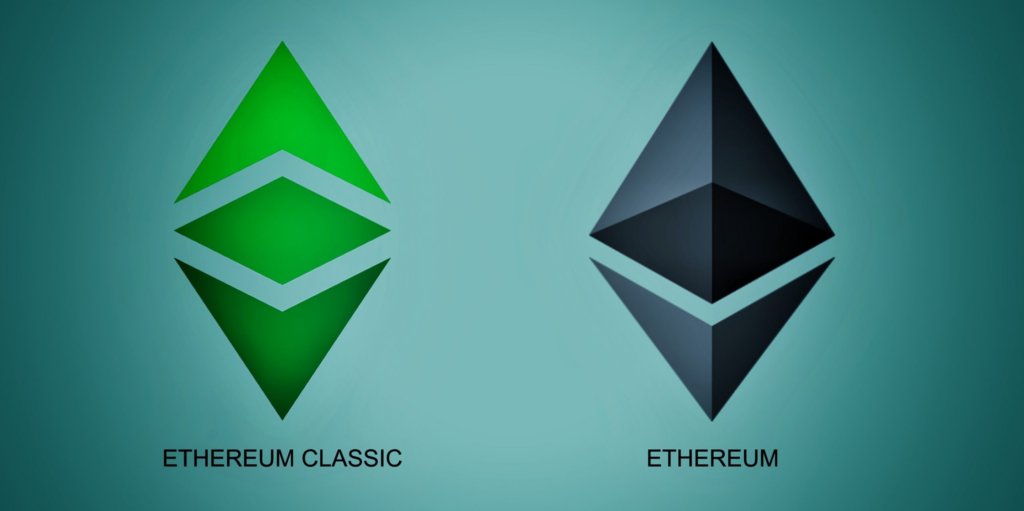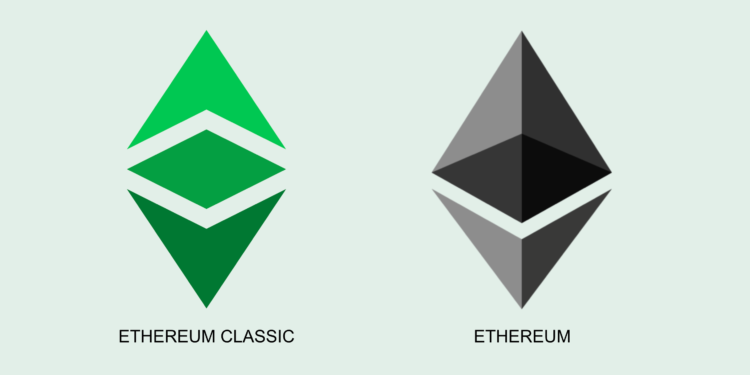- What Is Ethereum And Ethereum Classic?
- Ethereum vs Ethereum Classic Split: How Did The Fork Happen?
- Key Differences Between Ethereum And Ethereum Classic
- Concepts and Creation
- Transactions and Speed
- Supply and Distribution
- Use Cases and Target Market
- Ethereum Classic vs Ethereum: The Way Forward
- FAQ
While Bitcoin was the original cryptocurrency ever made, others have since emerged that offer extra functions, advantages, and applications. For instance, Ripple and Litecoin are even faster and have lower fees. At the same time, the Ethereum network is a blockchain platform with a primary focus on smart contracts. This platform may be put to use to develop a variety of decentralized applications, which are also referred to as Dapps.
However, were you aware that Ethereum was first developed under the name Ethereum Classic? Following a disagreement in the cryptocurrency community on how to respond to a hack, the two blockchains end up splitting apart, and the Ethereum fork produced two new cryptocurrencies: Ethereum (ETH) and Ethereum Classic (ETC).
Read this guide that compares Ethereum vs Ethereum Classic to find out which of the two cryptocurrencies is the better investment for you and whether or not it is worthwhile to invest in Ethereum or Ethereum Classic.
What Is Ethereum And Ethereum Classic?
The Ethereum Virtual Machine (EVM) is effectively a giant decentralized supercomputer that developers may utilize to build smart contracts for running Dapps or decentralized applications. Because these Dapps can be written to function in any way, it has led to the birth of a vast business that is known as decentralized finance (DeFi).
The Ethereum blockchain technology can be used to launch new coins for other projects. During the crypto hype bubble of 2017, Ethereum was the platform of choice for launching initial coin offerings, commonly known as ICOs. Initial coin offerings are new, crowdfunded ERC-20 tokens that investors acquired in search of getting the next Bitcoin or Ethereum before everyone else. It contributed to Ethereum’s explosion and growth to its all-time high of $4,811 during the apex of the bull market in 2021.
Today, the price of Ethereum is struggling at around $1,733, following the crypto winter since the start of 2022. DeFi has the ability to supplant traditional finance with uncensorable lending and borrowing, but NFTs have attracted celebrities from many walks of life, including athletes, entertainers, and other types of well-known people. These influencers draw a large number of consumers to the crypto sector, and the majority of what they use today is powered by Ethereum. Using Ethereum necessitates ETH for gas expenses, which contributes to the price increase of ETH.
Ethereum has emerged as the clear winner in this Ethereum vs Ethereum Classic debate. For instance, Wall Street has now begun to pay attention after witnessing Ethereum’s widespread use. Jim Cramer, for instance, believes that Ether will surpass Bitcoin due to the reasons outlined above. But before any of these more favorable events occurred for the leading altcoin, an Ethereum fork was required because of a problem with a decentralized autonomous organization known as “DAO” and a linked hack that almost cost consumers millions of ETH. The fork caused the Ethereum blockchain to divide into two channels and tokens: ETC and ETH.
The initial blockchain of Ethereum was given the name “Classic,” while the newly forked Ethereum that was reached by consensus took the place of Ethereum as it was previously known. Nevertheless, some individuals in the community refused to quit the Ethereum Classic blockchain, and it remains alive to this day, albeit with a fraction of the support and attention.
Ethereum vs Ethereum Classic Split: How Did The Fork Happen?
When Vitalik Buterin, the founder of Ethereum, suggested the fork, two distinct Ethereum blockchains were created. The first blockchain was rebranded as Ethereum Classic, while the updated version of Ethereum continued to develop. In contrast to the Bitcoin and Bitcoin Cash forks, which were motivated by ideology, the Ethereum fork was required to avoid a catastrophe that would have led to a total breakdown of the Ethereum market.
In the cryptocurrency market, Ethereum is represented by the ticker symbol ETH, whereas Ethereum Classic uses the crypto ticker symbol ETC. Both native cryptocurrencies are named “Ether,” which is the fuel that drives the Ethereum Virtual Machine and the network of supercomputers. The Ethereum split occurred in July 2016, at the same time as Bitcoin’s halving, and contributed to bringing cryptocurrencies into the global spotlight in 2017.
Key Differences Between Ethereum And Ethereum Classic
The code behind Ethereum and Ethereum Classic has been separated into two different pathways. But how these two methods have evolved over time has strongly affected the speculative value of each asset. Due to their close proximity, there are relatively few differences between them, but those differences are significant. Let’s continue the Ethereum vs Ethereum Classic debate while seeing their key differences.

Concepts and Creation
After becoming obsessed with Bitcoin and blockchain technology, the young engineer Vitalik Buterin conceived the idea that would later become Ethereum. After coming to the conclusion that the first cryptocurrency asset had some shortcomings, he set out to develop his very own cryptocurrency platform by making use of the newly available technology. This platform was intended to enable smart contracts, which are digital agreements that are structured to operate and behave in a particular way.
Coded smart contracts may take the form of straightforward agreements, such as those used in the sale of real estate, or they may take the form of more complex programs that operate decentralized markets, decentralized financial applications, and a great deal more. For instance, the Ethereum-based Uniswap smart contract functions as its own exchange.
Ethereum Classic is capable of doing any task that can be accomplished with Ethereum, despite the fact that the development community has basically abandoned it. The DeFi Pulse chart, which displays a total value in ETH locked up and not ETC, is a wonderful visual representation of this concept. Due to the lack of support, no DEXs, dApps, NFTs, or anything else has been constructed on Ethereum Classic, and the coin has been subjected to multiple 51% attacks.
Transactions and Speed
Transactions and speed are important, especially when one is doing the Ethereum vs Ethereum Classic debate. The speed of transactions on both platforms is between 12 and 15 per second on average, and the amount of time it takes for Ether to be received is very variable and proportional to the amount of ETH gas costs paid. The faster the transaction, the greater the expense.
In addition to the fact that Ethereum transactions need ETH to transmit, even ERC 20 tokens generated on Ethereum need ETH to send. This ensures that the asset is always in demand, which increases as more tokens are developed for the platform. The ETH 2.0 update, which has been rolling out since 2020, will allow for more transactions per second on Ethereum. With the ETH 2.0 update, 32 ETH are required to enable staking, and the number of ETH in the contracts grows daily.
Supply and Distribution
The total supply of Ethereum is a contentious issue. Recent claims by several prominent Ethereum developers that they did not know the total quantity were contested by the Bitcoin community. According to Ethereum core engineer Martin Holst Swende, the current total amount of ETH is approximately 112 million.
According to CoinMarketCap, the supply of Ethereum Classic is 118,000. The Securities and Exchange Commission (SEC) views cryptocurrencies as commodities rather than securities if they are sufficiently decentralized. Ethereum is among these cryptocurrencies, furthering the use of cryptocurrencies by organizations.
Use Cases and Target Market
Both of these cryptocurrencies were developed with the intention of accomplishing the same goals, addressing the same use cases, and catering to the same audience. As a result of this, Ethereum Classic is frequently seen as an “attack” on Ethereum, given that it competes with Ethereum for a similar share of the market and customer base.
However, there is no real competition. No DeFi apps or NFTs are created on ETC, and its market capitalization is towards the bottom of all cryptocurrencies. Ethereum is the leading altcoin, second only to Bitcoin among all cryptocurrencies. Ethereum is destined to remain master, while Ethereum Classic will continue to fall into oblivion. Trends frequently alter, but not in the case of the Ethereum vs Ethereum Classic debate.
Ethereum Classic vs Ethereum: The Way Forward
In this discussion about Ethereum vs Ethereum Classic, Ethereum has emerged as the unquestionable victor. Ethereum is the most bullish alternative currency in the market right now because it has almost everything going for it. The vast majority of the remainder of the cryptocurrency market is constructed on top of Ethereum’s smart contracts, and the vast majority of other tokens require ETH in order to function, keeping its demand high. Ethereum is fundamental to the DeFi and NFT developments that have exploded in crypto during the past few months. Ethereum is the leading alternative cryptocurrency, second only to Bitcoin in terms of market capitalization.
On the other hand, Ethereum Classic is now placed number 20 on the market capitalization list of cryptocurrencies, a position it barely merits. The cryptocurrency is more of a financial trap for inexperienced crypto traders who mistake it for Ethereum. ETC remains high-risk crypto, compared to other currencies in the developing asset class, due to the fact that 51% of its transactions are attacked.
FAQ
What Is The Difference Between ETH and ETC?
The primary distinction is in the viability of each asset as a long-term investment. Ethereum Classic is frequently attacked and may never be utilized again, whereas thousands of currencies and decentralized applications (DApps) employ Ethereum.
Does Ethereum Classic Have A Future?
Ethereum Classic may not have a very bright future, but it is still going to have one. As long as the community continues to provide the meager amount of support it needs, it will survive.
Which Is Better, Ethereum or Ethereum Classic?
Ethereum is the finest investment option by a wide margin. Ethereum is also a superior asset to trade due to its greater natural market volatility as a result of its widespread use and trading in the cryptocurrency market. The price of Ethereum Classic hardly ever fluctuates because nobody is interested in it anymore.























